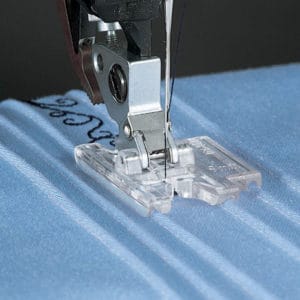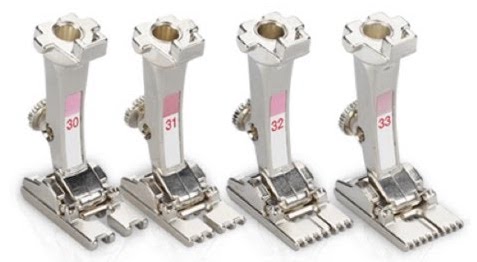When sewing machines only sewed straight stitches, sewers added creative details using what they had to work with. To add fancy accents, the fabric was often folded and stitched to form rows and rows of tucks or pleats depending on the size of the seam. This vintage work can be seen in old-time photographs of woman’s clothing. Though we don’t see as many tucks on clothing today, you can still find a plethora of tucks and pleats in heirloom-type sewing.
Traditional tucks are mostly stitched along a folded edge of the fabric. Varying the stitch depth from close to wide will give the fabric different looks. And spacing the tucks at different intervals can lend itself to even more final variations.
Once zig-zag sewing machines and double needles were invented, other variations on the traditional tucks and pleats evolved resulting in what we call pintucks today.
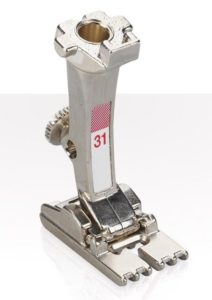
A pintuck is sewn by using a double needle with a pintuck foot using a straight or decorative stitch. The grooves on the bottom of a pintuck foot help guide previously sewn pintucks perfectly parallel to the new pintuck. Having two threads running through the machine into the double needle will begin to pinch the fabric and raise it up. Pintuck feet help you achieve a variety of options. And forget about only sewing straight lines, pintucks can now be sewn as curves or even into shapes!
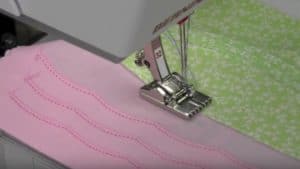
What Size of Pintuck Foot Should I Buy?
Pintuck feet come in multiple sizes. Pintuck feet can be found with 3, 5, 7, or 9 grooves. For lighter weight fabrics select the 5, 7, or 9 groove pintuck feet and save the 3 groove pintuck foot for heavier fabrics. We recommend purchasing a 5-groove pintuck foot as your first foot size and then adding additional sizes based on your fabric choices in the future.
What Size of Double Needle Do I Need?
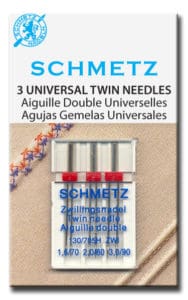
The double needle size must match the pintuck groove width. If you don’t know what size of the foot or what size of double needle you own, lay the double needle in the grooves of the foot. If they fit between the grooves it will work.
1.6 (use with 9 groove foot)
2.0 (use with 7 groove foot)
2.5, or 3.0 (use with 5 groove foot)
4.0 (use with 3 groove foot).
How Do I Thread a Double Needle?
To thread a sewing machine for double needle work, hold both threads together as one, and thread them through all thread guides up to the needles, then put one thread through each needle. Here is a video to help with threading a double needle:
Some machines even have a double needle safety option where a sewing machine can be alerted that you are using a double needle and it will limit all stitches so it will not accidentally stitch too wide and break the needle. Without this feature be sure the selected stitch is not wider than the foot.
What are Corded Pintucks & Shadow Pintucks?
Corded pintucks have a cord incorporated on the underneath side which gives body and a prominent appearance to the pintuck. Shadow pintucks use a brightly colored cord that shows through under very light fabrics.

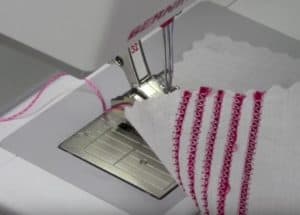
Alternative uses for the pintuck feet: The center groove on the three groove foot can be used to guide and sew over cords or 1/8” elastic on the top of the fabric, a technique called couching.
The 5 groove foot can even be used as an invisible zipper foot in a pinch!
Variations of machine brands of pintuck feet:
Bernina Pintuck Feet
Bernina 3-Groove Pintuck foot #30 for heavy fabrics
Bernina 5-Groove Pintuck foot #31 for medium-weight fabric
Bernina 7-Groove Pintuck foot #32 for light fabric
Bernina 9-Groove Pintuck foot #33 for very lightweight fabric
Bernina Pintuck and Decorative Stitch foot #46C which is a clear sole pintuck foot to combine decorative stitches in perfectly parallel rows with pintuck lines.
Bernina Pintuck Attachment
Viking Pintuck Feet
Husqvarna Viking 3 Groove Pintuck Foot with Raised Seam Plate Husqvarna Viking 7 Groove Pintuck Foot Husqvarna Viking 9 Groove Pintuck Foot
Pfaff Pintuck Feet:
Pfaff 5-Groove Pintuck foot – Part #820226096
Pfaff Pintuck Blade – Part #820678096
Pfaff 9-Groove Pintuck foot with Decorative Stitch Guide – Part #820776096
